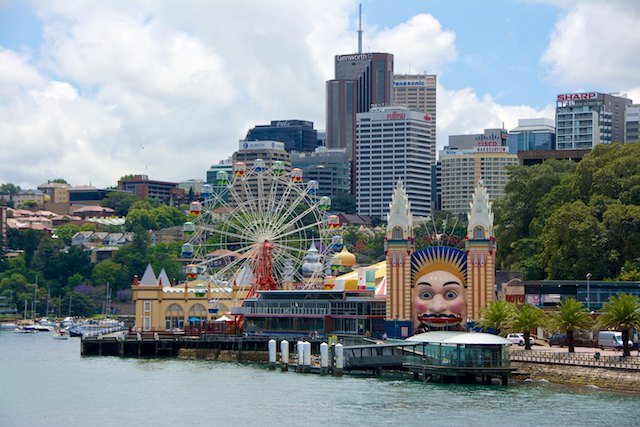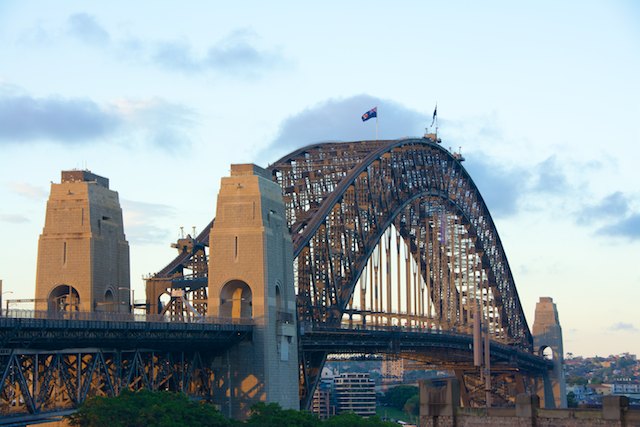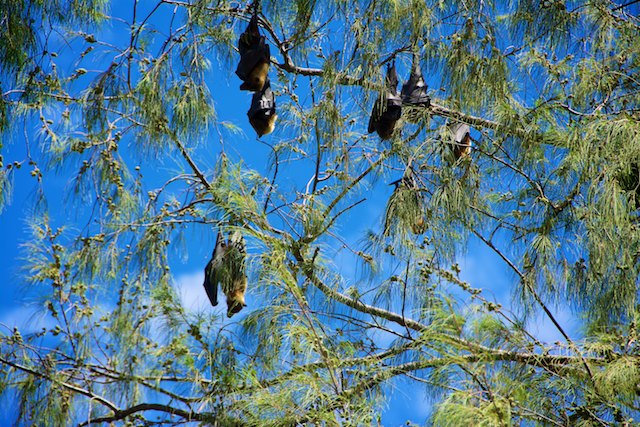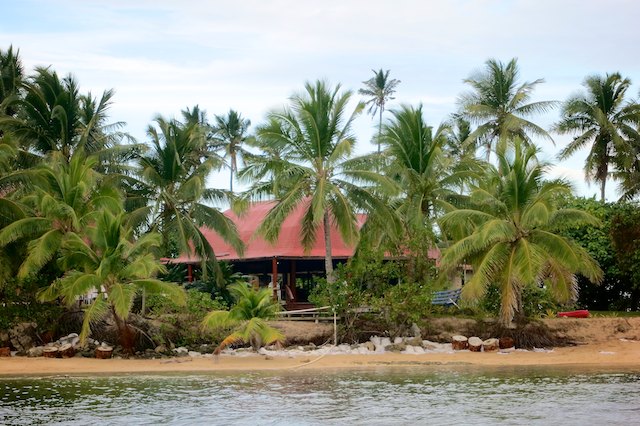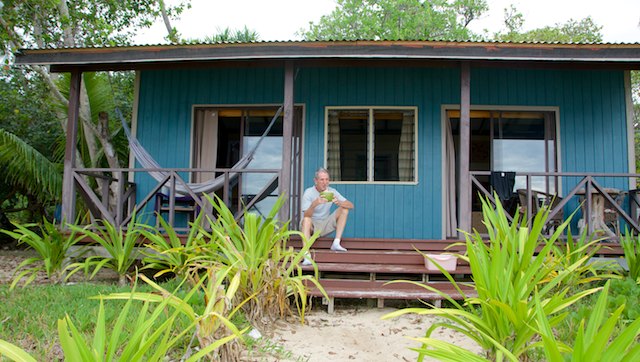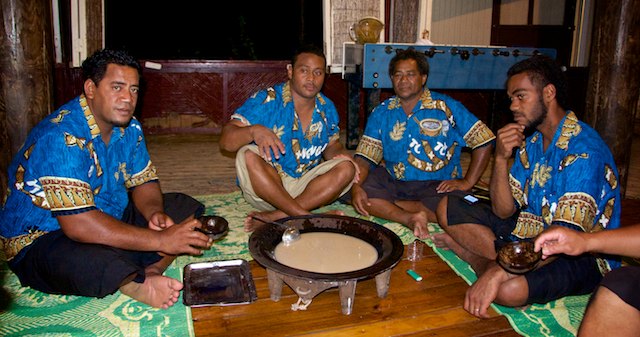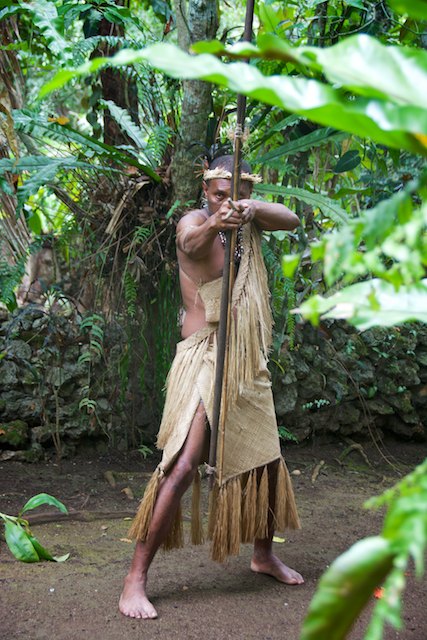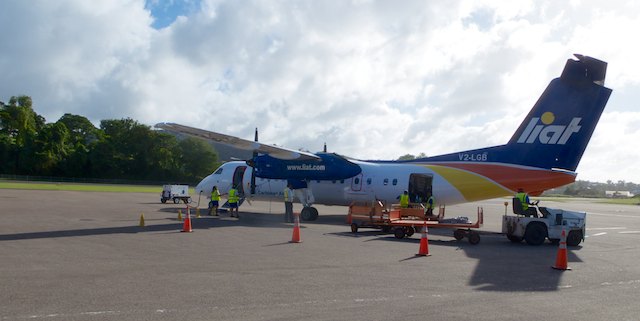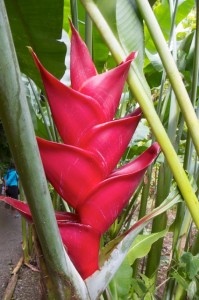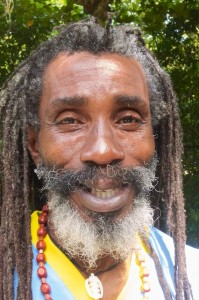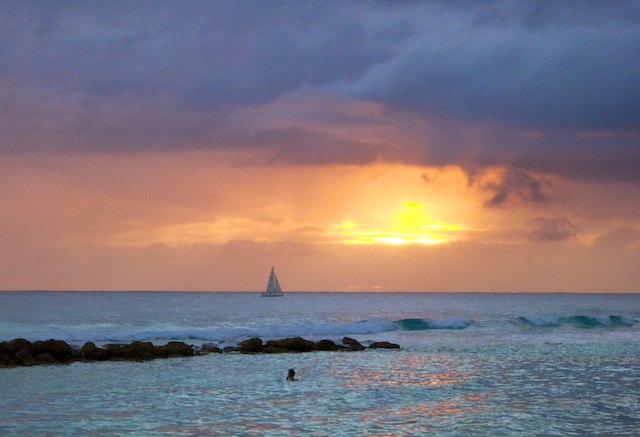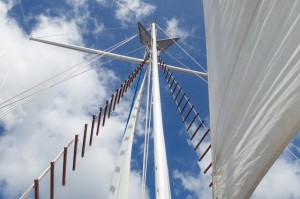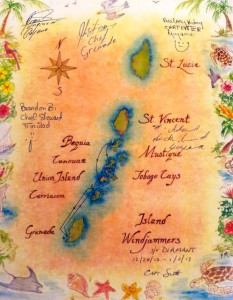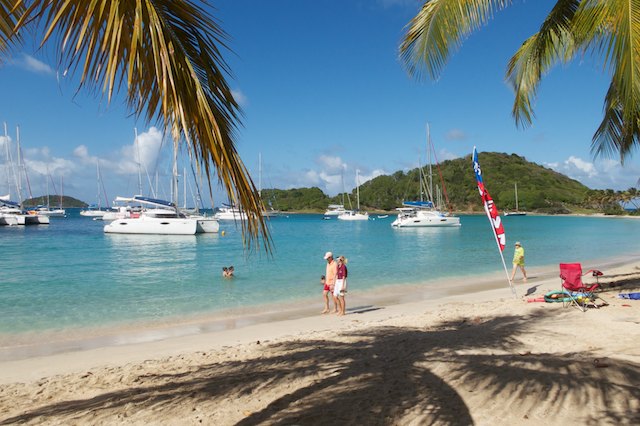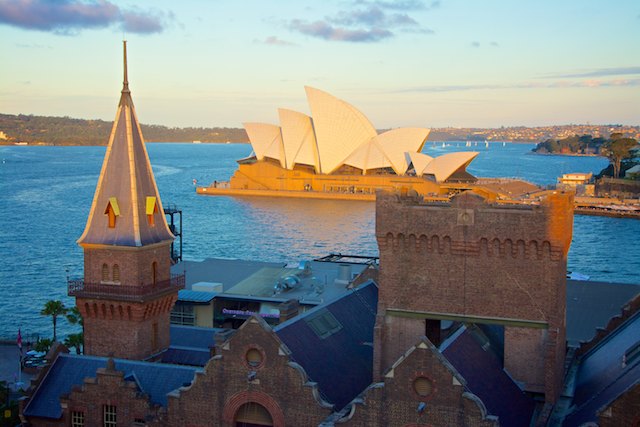
Dateline: Sydney, AU
There is a distinct possibility that my intrepid traveling companion has become unpardonably spoiled by the practice of hiring private cars and liveried drivers to transport us to and fro in foreign cities. In Sydney we were told that doing so would be wasting good money, and Sydney is a touch on the expensive side. Not New York expensive or San Francisco expensive, but a private car for two costs more money for an airport transfer than the purchase price of my first car (in 1968 dollars). Needless to say, we took the recommended “shared van”.
The “shared van”, (once we arrived in rainy Sydney), was over an hour late. Ordinarily, no big deal, but since our flight out of the airport in Nadi, Fiji had been delayed by 8 (count ‘em, EIGHT) hours, and we’d run out of Fijian currency prior to noon, so our only sustenance for the day was something labeled “SNAX” by the airline, well…let’s just admit this: Pablo was not his usual affable traveling self. When you’ve become accustomed to strolling out of Arrivals or Customs and a competent, uniformed somebody is waiting there with a smile and your name on a sign (or these days more likely an iPad)… well, can we all agree? It’s easy to get used to that.
So after several costly international phone calls (an indulgence Pablo only allows himself under dire circumstances) we finally located the driver (who had been unhappily torn away from his own Sunday supper to meet a bunch of delayed flights). He informed us that we had another lengthy wait in store for us as he was also picking up another large group of passengers coming in from Asia. Because we had paid a non-refundable fee, (a respectable sum, though not nearly as pricey as a private car) in advance, chucking the van and just hiring a cab seemed needlessly wasteful.
The driver went off to corral his other passengers and we settled in (to ration our last hoarded miniature bag of “SNAX”), and to wait.
We had been forewarned that, much like Los Angeles, Sydney is a town that rolls up the sidewalks quite early on a Sunday night. As the minutes ticked by I could see Pablo’s anxiety ratchet up regarding the acquisition of a decent meal. (Think lion’s cage. Think shark tank. You can ask anybody who knows him, for a skinny guy, he LOVES his food.)
He was in such a state by the time the Asian flight arrived I grew fearful that he might “lose his filters”, as they say. I REALLY got worried when only a small portion of the party from Asia arrived explaining that the rest of their group was “on the way” down from the gate, but would require some “special assistance”.
When everyone was at long last present and accounted for, I thought about James Michener. Have you read James Michener’s “Hawaii”? (You should.) Michener’s description of the customs of 17th century Hawaiian Royalty, specifically the custom that force fed them (like French geese destined to become foie gras), until they had grown in girth to proportions that prohibited simple perambulation, is an interesting examination of variances in cross cultural attitudes toward obesity. In Hawaii, the obese royals were revered and attended to obsessively, even to the point of being carried around on pallets by small armies of loyal, adoring subjects, much like the Caesars of ancient Rome, who were not known to be fat so much as just lazy and incredibly arrogant. These were my thoughts about our fellow passengers, although it must be reported that the “Queen” among this group notably rejected our driver’s proffered wheel chair and insisted on making her way (slowly, ever so slowly) under her own steam to the car park. Her entourage seemed thrilled at her woefully slow progress. (Much to Pablo’s ever increasing dismay.)
Once we arrived at long last at the exit, and the driver brought the car around, there was a protracted negotiation about where this particular passenger was going to sit. (We stayed out of it but the driver became quite animated during this discussion mentioning many mechanical car parts, things like shock absorbers and axels and wheel wells. Next, it took 3 people and about fifteen minutes to push/pull her inside the van. Seat belt? Not going to happen, but not for lack of trying on the part of her family and the driver. (For another fifteen minutes.) Pablo was apoplectic by then. (I did not think it prudent to point out to him the amusing absurdity of panic over missing one single meal in the face of such a tableau. I have learned that a starving man’s sense of humor is usually the first thing to go.)
Of course, by the time we arrived at our lodgings, the restaurant in the Holiday Inn at the Rocks in Old Sydney was in black out mode. Ditto every reasonable eating venue within 10 miles. Only the Pancake house on the corner was open. It took us all of 45 seconds to off load our luggage and high tail it down the street to partake of some pancakes or ANYTHING. Pancakes on the Rocks is one of those strange establishments that knows its place among eateries. They seem to cater to the “after hours” crowd of hipsters who all work in food service and then meet up there for “lates”. I guess. I can think of no other reason for them to be busy at midnight on a Sunday night other than it’s the only game in town. Certainly not the food. But, they were just moderately busy. There were a few empty tables. Still, they made us “sign in” and then wait for a table. Some kind of weird protocol. They actually made us wait outside. In the rain. Welcome to Sydney!
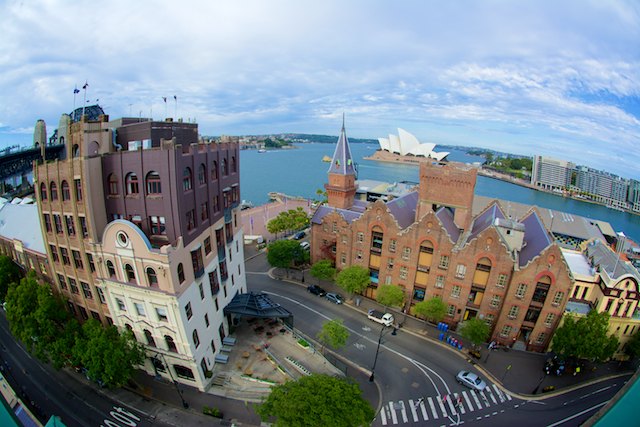
The Holiday Inn is positioned so that some of the (upgraded) rooms have a view of the harbor and the Sydney Opera House. It is one of those midnight views from a hotel room that takes your breath away and kind of makes up for a crumby dinner. Upon waking in the morning however you will be dismayed to find that, while you were slumbering, an enormous cruise ship arrived in the harbor to completely obliterate that view for the whole of the day. (They leave Sydney at around 5 o’clock so until then, your “view” is of a passenger boat with presumably a population roughly the size of Cleveland, Ohio. A big boat.)
The H.I. restaurant serves a pricey buffet breakfast, about US$30. Per person. So we wandered out the back door and happily located the Fine Food Store which was exactly as advertised. Plus they give you free weefee connect. Less a store than a little café, it gets a morning rush, but the food is cooked to order and everything we ate over our 3 day stay was gourmet fare at half the cost of the hotel. Pancakes at the Rocks rapidly became just a bad dream.
You will probably get suckered into “climbing” the Sydney Harbor Bridge if you watched Oprah do it a few years ago – the thing to do in Sydney – but it will cost you US$200 each for the privilege. Let me spell that out for you. TWO HUNDRED DOLLARS. Per Person. We walked across for free, and because it was raining and completely fog-bound, we felt virtuous (and clever) about saving the dough. That said, I might recommend climbing it if you can do it on a splendidly clear day since Sydney is a beautiful city and the whole of the bay is quite stunning.
An alternative, and one we took, was a harbor cruise. These are like ferries or riverboat cruises and a good second to having a private sailboat show you around. Even the lunch served was pretty damn delicious. We were coerced into breaking with our normal abstemious day time habits and drinking a (few) mid-day alcoholic libations, since you pay for it either way. The boat cruises all around the bay and circles back to Darlington Harbor. You can hop off there and walk back to the Rocks if you so choose. It’s a bit of a hike but gives you a real sample of the city and its inhabitants. (Plus you need the exercise after the binge.) Darlington harbor itself is a big tourist trap. The Sydney Rue du Crappola. We had neglected to bring sunscreen or hats because it had been raining when we left our hotel, so we were forced to buy both. (Sorry about your inheritance, kids.) Then, we couldn’t get out of there fast enough.
Our second evening we strolled down the street to have tapas and wine at The O Bar, a revolving restaurant that makes one full 360 degree revolution in just under two hours. A perfect amount of time for tapas, a few drinks and dessert. This is a city place on the 47th floor of a downtown business center building, full of happy hour gentry and young, trendy Sydney locals. The food was outstanding and the service was impeccable by a fleet of young, knowledgeable and friendly servers who were very happy to chit chat and inform. I wound up buying the chef’s cookbook because the menu was so impressive and his recipes boasted themselves to be heart healthy and low on the sugar index.
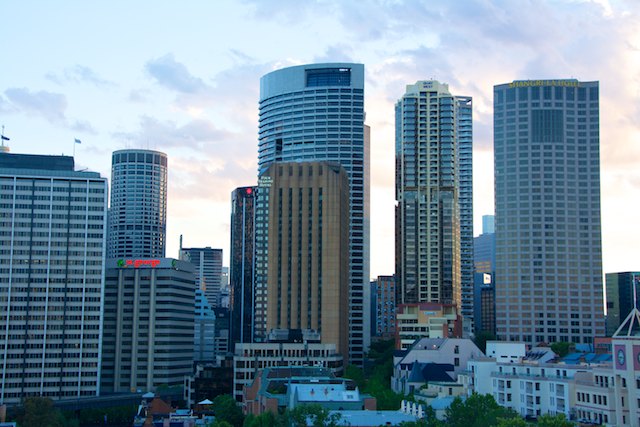
The next afternoon we sought out some galleries and checked out the Sydney Museum of Contemporary Art. You’re going to accuse me of hyperbole here, but I swear the premiere installation at the MoCA was just a large dark room full of more than a dozen dumpsters, all filled to the brim with mining ore. I guess it was a tribute to the importance of mining. Or sheer ugliness. Or, industry…? Dunno. Don’t care. This is art? At the end of the day my consensus was thus: If not for indigenous aboriginal art (which is both primitive and often beautiful) in Australia, there would be NO ART in Australia at all. Pablo says I’m being uncharitable. You be the judge. I’m willing to be corrected.
Our final night in Sydney was spent dining just behind the Holiday Inn on the heated patio of a sweet little Italian joint Caminetto that was both authentic and comfy-cozy in spite of the chilly weather. Nice people, owner operated, a stone’s throw from the hotel, and great food and wine. What could be better?
Pablo contacted the “shared van” people the next morning and tried to get them to pick us up earlier than contracted because we had our doubts about their estimations for travel from Old Sydney to the airport, but they insisted there was “plenty of time”. Actually, they were correct. There was “plenty of time”. We thoroughly enjoyed the mid-city, rush hour traffic ride, (our driver was obviously a race car driver when he wasn’t piloting the “shared van”), and the sprint from the van to the airline check in counter was ever so much fun. Plus, a complimentary reminder from the “shared van” people that there are way worse things in life than missing a flight.
